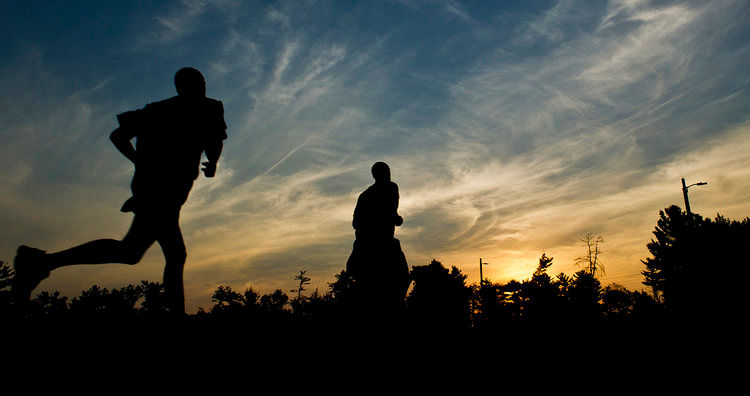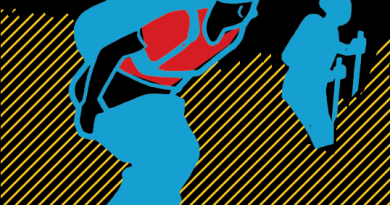How to Train in the City to Prepare for the Mountains
Get fit for your next adventure even while you’re stuck in town with these tips from a pro trainer.
1) Get Sport-Specific
I learned the hard way when I started coaching that general fitness only gets you so far in the mountains. Two of my lessons stand out. First, general fitness strength and barbell training doesn’t do much for rock climbing performance. I learned this lesson directly when I tried to follow a mountain guide I coached up some easy 5.8-5.10 trad routes. I could do front squats all day long, but halfway up the route, my grip was gone and I was peeling off the rock.
Second, concentric strength doesn’t transfer to eccentric strength. My first year, our alpine ski dryland training was dominated by heavy front squats, lunges, back squats, dead lifts, et cetera. When the ski resort finally opened, my athletes’ legs were weight-room strong. The following Monday, however, they were cussing me out: two runs into opening day, their legs were mush. It turns out that alpine skiing demands eccentric leg strength: gravity bounces you down the hill, and each time you touch the mountain with your skis, it wants to force you into the ground. We had spent the pre-season training concentric strength instead.
There are no quick fixes or short cuts. If you have a rock climbing trip planned, you should spend your pre-trip training time primarily in the rock gym climbing routes, bouldering, and working the system, campus and other grip-training equipment. Mountain biking trip? You should be on your trainer, spinning and working in some upper body strength. Backpacking trip? Throw on a 30-to-50-pound pack, hike some distance, and hit up vertical terrain like stairs and hills.
2) Hammer on the “Mountain Chassis”
Most mountain sports start with the legs, lungs and core. I call these the “Mountain Chassis.” Your general fitness training should focus on exercises like squats, lunges, leg blasters, hinge lifts, loaded step ups, distance running, sprinting, sandbag get ups, and isometric core bridging. Legs, lungs and core are your “engine” in the mountains.
3) Train Vertical
If you’re on a mountain trip, you’ll likely be going up and down. Train going up with loaded step-ups or by climbing stairs wearing a pack. This will not not only train quad, core, and calf strength, but also mode-specific cardio. Train for descents with leg blasters. Remember, it’s the downhill which will put more strain on your body and leave you sore.
4) Get Trip-Specific
Planning a peak bagging trip with 4,000 feet of vertical gain and loss and 10 miles round trip wearing a 20-pound pack? Train until you can run and walk six miles, do 2,000 step-ups, run and walk another six miles, and do another 2,000 step ups with a 20-pound pack. It’s better to over-prepare so you’ll be ready for the unexpected. There are no shortcuts when it comes to training time: you have to train long to go long.
5) Use the Week to Train Fitness Attributes, and the Weekend for “Mini Events”
Completing a long training session like the one described above will take several hours. Most won’t have time during the week to complete it. Use the shorter, 60-to-90-minute weekday training sessions to train specific attributes—say, step-ups on Monday, running on Tuesday, step-ups and core on Wednesday, and so on. Use the weekend to combine exercises together into longer “mini events”—think 1,000 step ups followed by a six-mile run, followed by another 1,000 step-ups. Make your mini-events longer and harder until they reach, or nearly reach, the duration of your actual trip.
6) Use Mini Events to Test Gear and Nutrition and Train Mental Fitness
Train the way you’ll play. Wear the same shoes, clothes, pack, and eat the same food, gels, and supplements you plan to use on your trip or event. The middle of a long climb or backpacking trip isn’t the time to find out your boots cause massive blisters, your pack’s shoulder straps aren’t padded well enough, or the brand of gels you planned to eat makes you throw up after a couple hours.
Mini-events are also great for training your mental fitness for long pushes. We’ve seen this ourselves and heard it from athletes training for military selections and dangerous alpine climbs.
7) Think of Training as Part of the Experience
Straight up: 1,000 step-ups wearing a 40-pound pack is pure drudgery. There’s nothing fun about it. But the mountain doesn’t care: there’s no special summit for city folk who decided not to train appropriately, or busy executives who work 60-hour weeks. Each mountain has one summit, and there’s no escaping the work to get to it. Embrace it: putting in the time and work to appropriately train for your mountain trip will add to the overall experience, and make the trip more enriching and authentic. You may never learn to love step-ups, but after a few weeks, you’ll at least appreciate them as a tool for making your body and mind mountain-fit.
The article was originally seen at https://www.backpacker.com/skills/how-to-train-in-the-city-to-prepare-for-the-mountains
Originally posted 2018-04-18 19:04:05.




